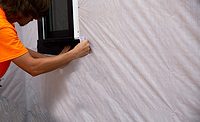New Acrylic Block Elastomer for Adhesive Applications
Developed using proprietary living anionic polymerization technology, a new acrylic thermoplastic elastomer is suitable as an adhesive for masking tape, packaging, surface protection film, double-sided tape, and as an anti-slip film.

monsitj / iStock / Getty Images Plus via Getty Images
The authors have developed the world's first acrylic thermoplastic elastomer (TPE) with the best weather resistance currently on the market, using proprietary living anionic polymerization technology. The acrylic TPE is a block copolymer consisting of two polymethyl methacrylate (PMMA) blocks (glass transition temperature: 100-120 °C) and a variety of acrylic ester blocks (glass transition temperature: -70 to -50 °C) in between them (Figure 1).
The size exclusion chromatography curve of the final block copolymer obtained by this technique shows a unimodal peak with no trace of the intermediate homopolymer (which is PMMA) or diblock polymer, and its molecular weight distribution is narrow, less than 1.3. The polymerization conversion of monomers at each stage is virtually 100%, and there are very few low molecular weight impurities such as residual monomers. Since the acrylic TPE is a block copolymer, the microphase-separated structure that can be obtained depends on the molecular weight and percent composition of each block, and the physical properties change with differences in these parameters. When the PMMA ratio is high, it takes on a lamellar structure and becomes a hard material that does not crack easily when bent, and is used as a molding material for smartphone cases and as a modifier for various resins (such as polycarbonate, ABS, and PVC).

On the other hand, when the PMMA ratio is low, the PMMA layer takes on a spherical or cylindrical structure and becomes a soft, stretchable, and self-adhesive material. In addition, since the PMMA blocks act as pseudo-cross-linking points, there is no need to introduce functional groups (such as carbonyl groups) for chemical cross-linking in the polymer, as is the case with conventional acrylic polymer solution resins. Since a high ratio of acrylic ester blocks in the polymer facilitates the development of self-adhesiveness, it is easy to confer high adhesive strength to the material even with a small amount of adhesion agent (hereinafter referred to as TF) or plasticizer. Therefore, it is characterized by low contamination of the adherend. With these characteristics, the acrylic TPE (trade name: KURARITY™) is available in both the LA series, which is copolymerized with n-butyl acrylate (nBA: glass transition temperature (Tg)s = -50 °C) as an acrylic ester, and the LK series, which is copolymerized with nBA and 2-ethylhexyl acrylate (2EHA: Tg = -70 °C).
Adhesive Applications
Basic Properties
The major types of adhesives are solvent, emulsion, and hot-melt. As a solvent adhesive, the acrylic TPE can be used by dissolving it in common organic solvents. In particular, it dissolves in VOC-exempt solvents as designated by the U.S. Environmental Protection Agency (Table 1), making it widely applicable.

In addition, it is attracting attention as a hot-melt adhesive because the drying and post-cross-linking processes are not necessary contributing greatly to environmental load reduction and energy conservation. In general, hot-melt adhesives using styrene block copolymers (SBCs) as a base polymer are widely used, but weather resistance, adhesion enhancement, and bleed-out of additives have become issues due to the large amount of added TF and plasticizers. The acrylic TPE, on the other hand, possesses weather resistance, transparency, self-adhesiveness, and other characteristics derived from the acrylic structure. Therefore, it is possible to design formulations that limit the amount of TF and plasticizers added and have excellent non-staining properties. It is advantageous for adhesive series to have a low PMMA block ratio. Table 2 lists their characteristics (KURARITY LA2140: High MFR, KURARITY LA2330: High SAFT, KURARITY LA3320: High tack, KURARITY LK9243: Low Tg). Rosin ester, styrene resins and terpene phenolic resins can be used as TF for adhesive compounds, and acrylic oligomers and dibasic acid esters can be used as plasticizers.

Performance Improvements
Recently developed grades provide further performance improvement (Table 3). These include:
- KURARITY LA3710 (low PMMA ratio, high molecular weight grade)
- KURARITY KL-LK9701 and KL-LK9211 (2EHA copolymerized grades)

Compared to conventional grades, LA3710 has high tack and high fluidity derived from its low PMMA composition and high tack and cohesion (based on adhesion at 90 deg and constant stress test) derived from its high molecular weight. In addition, because this grade has the most flexible properties derived from its low PMMA composition, adhesives made with 3710 flow into rough surfaces like mortar, plywood, and steel plates for improved adhesion compared to more rigid adhesives.
A cross section of the adhesive layer (Figure 2) shows that when a KURARITY compound system or a styrene compound system was pressure-sensitively bonded to a rough surface as an adhesive layer, the former conformed to the rough surface (surface irregularities). We believe that these properties, when utilized as a hot-melt adhesive composition in tapes and other products, will help to suppress misalignment and edge lifting after application while demonstrating high adhesive strength, and will be effective as an adhesive layer in removable tapes, stickers, wallpaper, and other products.

Two grades, KL-LK9701 (low PMMA composition, high molecular weight) and KL-LK9211 (high flow type), have lower polarity, lower Tg, and higher tack properties than the LA series, and have improved adhesion to polyethylene (PE), a low polarity base material. In addition, low-polarity additives (C5, C9, and paraffin oil) that are incompatible with the LA series can be added, making it possible to formulate adhesive formulations that exhibit adhesive strength for both high and low polarities. In addition, due to the low Tg derived from 2EHA, it can maintain tackiness even in the low temperature range of -10 °C or lower, which has been difficult for UV-curable acrylic adhesives and the LA series.
Conclusion
The above is an introduction to the development of a new acrylic TPE for adhesive applications, focusing on the development trends and basic properties of the new brand. The new acrylic TPE is suitable as an adhesive for masking tape, packing, surface protection film, and double-sided tape, and as an anti-slip film. Additionally, it has a wide range of applications beyond adhesives (Table 4).

These materials comply with the following U.S. FDA's regulations: 21 C.F.R. § 175.105 (Adhesives), § 175.125 (Pressure-sensitive adhesives), § 177.1010 (Acrylic and modified acrylic plastics, semi-rigid and rigid), and § 175.300 (Resinous and polymeric coatings). As one of the global efforts to reduce CO2 emissions, which are rapidly increasing in many countries around the world, there is a growing need for high-solid and hot-melt (solvent-free) materials; KURARITY is a material that can play a role in this trend. In addition to the grades introduced here, the LH series of new highly polar grades copolymerized with methyl acrylate are also under development.
Learn more at kuraray.com.
Looking for a reprint of this article?
From high-res PDFs to custom plaques, order your copy today!






